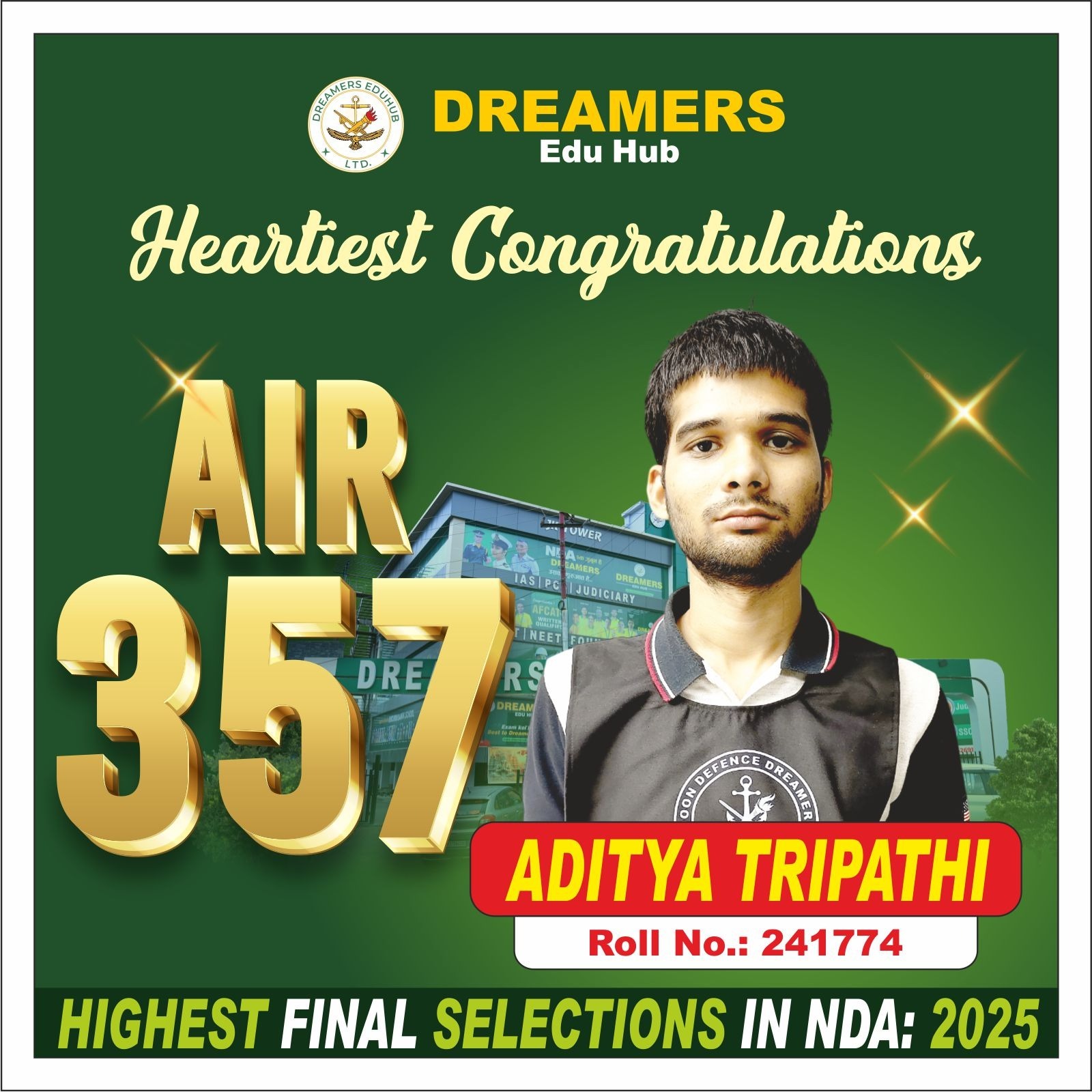NDA stands for National Defence Academy. It is India’s premier tri-service military academy where cadets of the Army, Navy, and Air Force train together before they go on to their respective service academies for specialized training. The NDA is located in Khadakwasla, near Pune, Maharashtra.
The primary purpose of NDA is to provide joint foundational military training and education to future officers so they develop an integrated outlook, leadership skills, discipline, camaraderie, and a basic understanding of all three services before specialization.
Candidates are admitted through a national-level examination conducted by the UPSC (Union Public Service Commission). The selection process includes a written exam followed by SSB interview, medical tests, and merit ranking.
After completing their training at NDA, cadets are commissioned into their respective service academies (Army, Navy, Air Force) to undergo further specialized training before being commissioned as officers.
Structure & Training at NDA
Course Duration & Academics
The training at NDA is three years long. During this period, cadets pursue an academic degree (typically Bachelor of Arts or Science) in parallel with military training.
Alongside academics, cadets undergo physical training, drills, weapon training, leadership development, sports, adventure training, and service-specific modules.
After the three years, those going to the Army wing proceed to the Indian Military Academy (IMA) for further pre-commission training, while Air Force and Navy cadets go to their respective specialized academies (Air Force Academy, Indian Naval Academy).
Hence, NDA combines military and academic education in an integrated way, so that graduates emerge not only as military trainees but also with a formal degree qualification.
Culture and Joint Training
NDA encourages jointness and inter-service synergy by having cadets of all three services live and train together. This creates mutual understanding, coordination, and inculcates a tri-service mindset early.
Many training elements are common: physical fitness, drills, leadership tasks, camps, social and behavioral training.
Service-specific modules (like aviation for Air Force cadets, navigation or naval subjects for Navy cadets) are embedded during or after the joint phase.
Value & Philosophy
NDA is not just about imparting skills, but shaping character, values, leadership, moral courage, discipline, selflessness.
It aims to build officers who can think, lead, and execute in complex environments, with integrity, adaptability, and a strong foundation in academics and ethics.
Because cadets spend three years together, there is continuity, peer bonding, and a more immersive developmental experience.
How NDA Differs from Other Military Academies
To understand the uniqueness of NDA, it’s useful to compare it with other key military academies in India, such as IMA, OTA, INA, AFA, etc.
1. Entry Level & Candidate Profile
NDA is an entry point directly after 10+2 (12th grade). It allows young aspirants (usually age 16½ to 19½) to join the armed forces at an early stage of life.
Other academies like IMA, OTA, etc., primarily take graduates or candidates who have already cleared undergraduate studies or who are selected through CDS, technical entries, or direct entry schemes.
Thus, NDA selects at a youthful stage, whereas others often select later after higher studies or through alternate commissions.
2. Integrated Academic + Military Training
In NDA, cadets combine degree education with military training over three years. This dual structure is unique.
In contrast, other academies (e.g. IMA for direct entries) focus largely on military training since the academic degree is already completed. Their curriculum is intensive in leadership, tactics, field craft, and service specialization.
For example, IMA cadets normally do not pursue additional full-time academics since they are already graduates; their training is military and professional.
3. Duration & Phases
NDA provides a three-year joint phase, followed by service-specific training.
Other academies often have shorter durations (one to two years) depending on entry path. For example, direct entry officers via CDS go to IMA for about 18 months or so of training.
OTA (Officers Training Academy) is another example, especially for Short Service Commission, with a shorter training span than cadets at NDA or IMA.
4. Commission & Type (Permanent vs Short Service)
NDA-trained cadets are eligible for Permanent Commission upon completion, subject to performance and vacancy, in most branches.
Some other academies like OTA are geared toward Short Service Commission (SSC), although in some cases SSC officers may get an opportunity to convert to Permanent Commission.
IMA is oriented toward those selecting Permanent Commission, especially via graduate entries or direct entries.
5. Jointness & Tri-Service Exposure
The NDA uniquely brings cadets of the three services together for foundational training — promoting jointness, holistic understanding, and coordination.
Other academies, especially service-specific ones (like Naval Academy or Air Force Academy), train solely in that service environment with specialization from the start.
That tri-service exposure at NDA gives cadets early insight into combined operations and inter-service perspective.
6. Career Planning & Early Commitment
Through NDA, cadets commit early to pursuing defense service careers, gaining more years of service potential, opportunities for promotions, and longer experience.
In direct or academy-based entries later, the decision is made later in career or after higher education, sometimes with less time to absorb institutional culture and holistic training.
7. Competition & Selection Intensity
NDA is among the most competitive exams in India, because many students with only 12th standard aim for it. The scale is huge.
Other academies, though competitive, take a smaller pool (graduates, technical candidates) and different selection criteria (CDS, university-level selection).
The screening, written exam, and SSB for NDA are rigorous and filter from a large aspirant base.
8. Role of Academia vs Pure Training
NDA places strong emphasis on “education + training” philosophy; besides military things, values academics, research, and intellectual growth.
Other academies heavily tilt toward military, operational, leadership, tactics training, with lesser academic burden (since candidates already have or are concurrently doing academics).
Pros & Cons of NDA vs Other Academies
Advantages of NDA route
Early start — Join right after school and build a long defense career ahead.
Degree + training — You get a formal degree alongside military education.
Tri-service exposure — Understand all arms and systems before specialization.
Longer service horizon — More years in service can translate to better experience, promotions, and senior roles.
Holistic development — Balances physical, mental, academic, leadership growth from the beginning.
Challenges or drawbacks compared to other paths
Maturity — Younger entrants may lack clarity, maturity, or life experience compared to graduate entrants.
Academic burden — Balancing academics + rigorous military training is demanding.
Flexibility — If one changes mind after a few years, switching out may be harder than entering later.
Branch flexibility — Some specialized branches may prefer graduate-level entrants.
High competition — Because it opens to a broad aspirant base, competition is extreme.
Recent Developments & Trends
Women at NDA: From 2021 onward, NDA has begun to admit female cadets, bringing gender integration to the academy.
Updated curriculum: More emphasis on modern warfare, technology, cyber, joint operations and strategic studies, not just conventional military training.
Greater specialization post-joint phase: Newer modules and pathways allow cadets to have advanced specialization shortly after joint training.
Higher rigour in leadership and character training: The training modules evolve to match modern security challenges, hybrid warfare, and changing global threats.
These developments ensure that NDA remains not just historic but adaptive to present and future defense demands.
NDA Coaching & Role of Institutions: Doon Defence Dreamers NDA Coaching
Success in NDA requires a blend of academic excellence, physical fitness, intelligence, and psychological strength. That’s where institutions like Doon Defence Dreamers come in.
Focused NDA Coaching: At Doon Defence Dreamers, the NDA coaching program is tailored to help students prepare for both the written exam and SSB process comprehensively.
Integrated teaching: The courses cover key NDA syllabus content (mathematics, general ability, English, science), along with physical training, mental aptitude, and exam strategy.
Mock exams & feedback loops: Regular full-length mocks simulate the real exam environment, helping students manage time, stress, and performance.
SSB & personality training: Since selection doesn’t end with the written exam, the coaching includes SSB interview prep, personality development, situational tests, and confidence-building.
Holistic growth: The academy emphasizes character, discipline, mentoring, and real-world exposure so aspirants are not just exam-ready but life-ready.
Personal guidance: Trainers at Doon Defence Dreamers assess individual strengths/weaknesses, offer personalized improvement plans, and mentor aspirants through the entire NDA journey — from exam to commissioning.
By aligning NDA coaching with real defense objectives and future career goals, such institutions give aspirants an edge in not only clearing NDA but building enduring military careers.
Sample Timeline: NDA Path vs Other Paths
Here’s a rough illustrative comparison:
| Stage | NDA Path | Graduate / Academy Entry Path |
|---|---|---|
| After 12th (age ~16–19) | Sit NDA exam → Join NDA → 3 years training + degree + move to service academy → Commission | Complete graduation → Sit CDS / direct entry exam → Join academy (e.g. IMA) |
| Training period | 3 years joint + further service-specific training | ~1–2 years of pure military academy training (depending on path) |
| Commissioning | Graduate + trained, then commissioned | Commissioned after academy as graduate officers |
| Service horizon | Maximum possible years in service | Slightly fewer years (depends on age of entry) |
| Exposure | Tri-service & academic + military | Mostly service-specific, heavier military focus |
Why Choose NDA Over Other Military Academies?
Longer career window — Starting early gives you more years to grow, lead, and serve.
Educational degree advantage — You graduate with a degree, which can help even beyond the military.
Versatility & exposure — Tri-service training gives a wider base before specialization.
Prestige & legacy — NDA carries a historic legacy and is often seen as the most desirable entry.
Better alignment for Permanent Commission — Many NDA cadets are well-positioned to obtain Permanent Commission, especially with sustained performance.
Conclusion
NDA (National Defence Academy) is more than an academy — it is the foundational crucible for India’s future officers. It merges academics with military training in a tri-service ecosystem, develops character and leadership from a youthful age, and gives cadets a long runway for their military careers.
While other military academies (like IMA, OTA, direct entries) have their distinct roles, specialization, and advantages, NDA stands apart in its holistic vision, early commitment, and integrated growth model.
Institutions like Doon Defence Dreamers play a crucial role in helping aspirants navigate this path. Through specialized NDA coaching, structured curriculum, physical and mental training, and mentorship, they prepare students not just to clear exams but to embrace a life in defense with confidence, competence, and commitment.




























